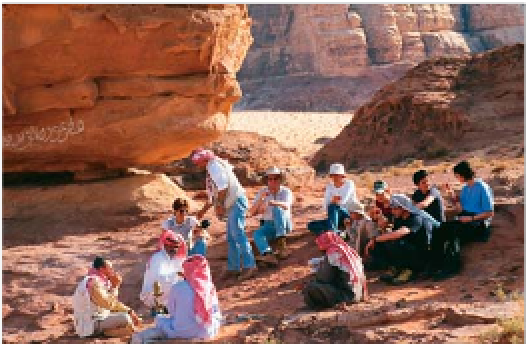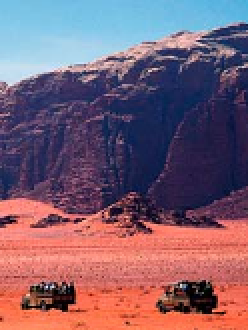Travel Reference
In-Depth Information
Exploring Wadi Rum
There are essentially two main ways to explore the
desert of Wadi Rum: through a combination of jeep and
hiking, or by camel trekking. Jeeps allow you to travel
further and faster, but the more traditional means of
transport will bring you much closer to the stillness
of the desert. Either way, make sure you carry lots
of water and avoid travelling during the midday heat,
especially in summer. For contact details of companies
organising Wadi Rum expeditions, see page 309.
Ulaydiyya, the small oasis
known as “Lawrence's Spring”
and the narrow
siq
(gorge)
of Khazali Canyon.
Other noteworthy attrac-
tions include the Nabataean
inscriptions and petroglyphs
of Anfaishiyya, the natural
rock bridge of Jebel Umm
Fruth and the various “sunset
sites”, which are all ideal
places to witness the
changing afternoon colours
of the desert rocks.
Tourists on a camel-trek through the
canyons of the Wadi
Adventure Activities
An excellent alternative to
making arrangements on the
spot is to arrange a more
active itinerary in advance
with one of Wadi Rum's
excellent Bedouin guides.
Most can arrange jeep and
overnight trips but you'll
need a specialist for climbing
or canyoning. Overnight trips
that combine a jeep excursion,
camel ride and some rock
scrambling are very popular.
Camel trekking is fun but
the pace is slow and can be
highly uncomfortable after a
couple of hours. Still, it is un-
deniably the best way to get
a feel for the desert in classic
“Lawrence” fashion. The three-
day ride from Wadi Rum
south to Aqaba
(see p235)
is a challenging adventure.
Horse riding is possible on
the periphery of the park, as
is mountain biking over the
desert flats.
It is well worth fitting in an
overnight at a Bedouin camp
during your visit. The larger
fixed camps can be touristy
but are fun nonetheless. The
smaller ones shift location
regularly and offer a more
authentic, but also more
basic, experience. The food is
generally excellent; you may
get to try
mensaf
(a
f
Bedouin
dish of lamb and rice) or, if
you are lucky, a “Bedouin
barbeque” - meat slow-
cooked in a desert oven
called a
zerb
. Reclining by an
open fire, gazing at the stars
and sipping a mint tea in the
stillness of the desert is
perhaps the quintessential
Wadi Rum experience.
Hiking
Many of the best trips offer
a combination of jeep travel
and hiking. The 5-km (3-mile)
stroll through the towering
walls of Barrah Canyon is a
favourite option. Some hikes
require a guide, such as the
excellent hour-long scramble
up to the Jebel Burdah rock
bridge and the exciting half
Jeeps, the best way to cover large
distances quickly in Wadi Rum
Jeep Tours
A wide range of jeep tour
A
options is posted at the main
reception gate, 7 km (4.5
miles) before Rum village.
If you have not pre-arranged
a trip, you will be allocated
a driver here. It is possible to
join up with other travellers
to share the cost of a jeep.
There are two main areas to
explore: the main southern
section of Wadi Rum and the
less-visited northern scenery
closer to the village of Diseh.
The most popular desti-
nations include the striking
red sand dunes of Jebel Umm
f
day hike through labyrinthine
Rakhabat Canyon.
Most trips require jeep
transport to get you to the
start of the hike. The only
walk you can really do by
yourself is from the visitor
centre east to Makharas
Canyon and back; take a
guide if you are unsure of
your route-finding skills.
Hikers taking a break with their Bedouin guides
For hotels and restaurants in this region see pp262-3 and pp279-80












